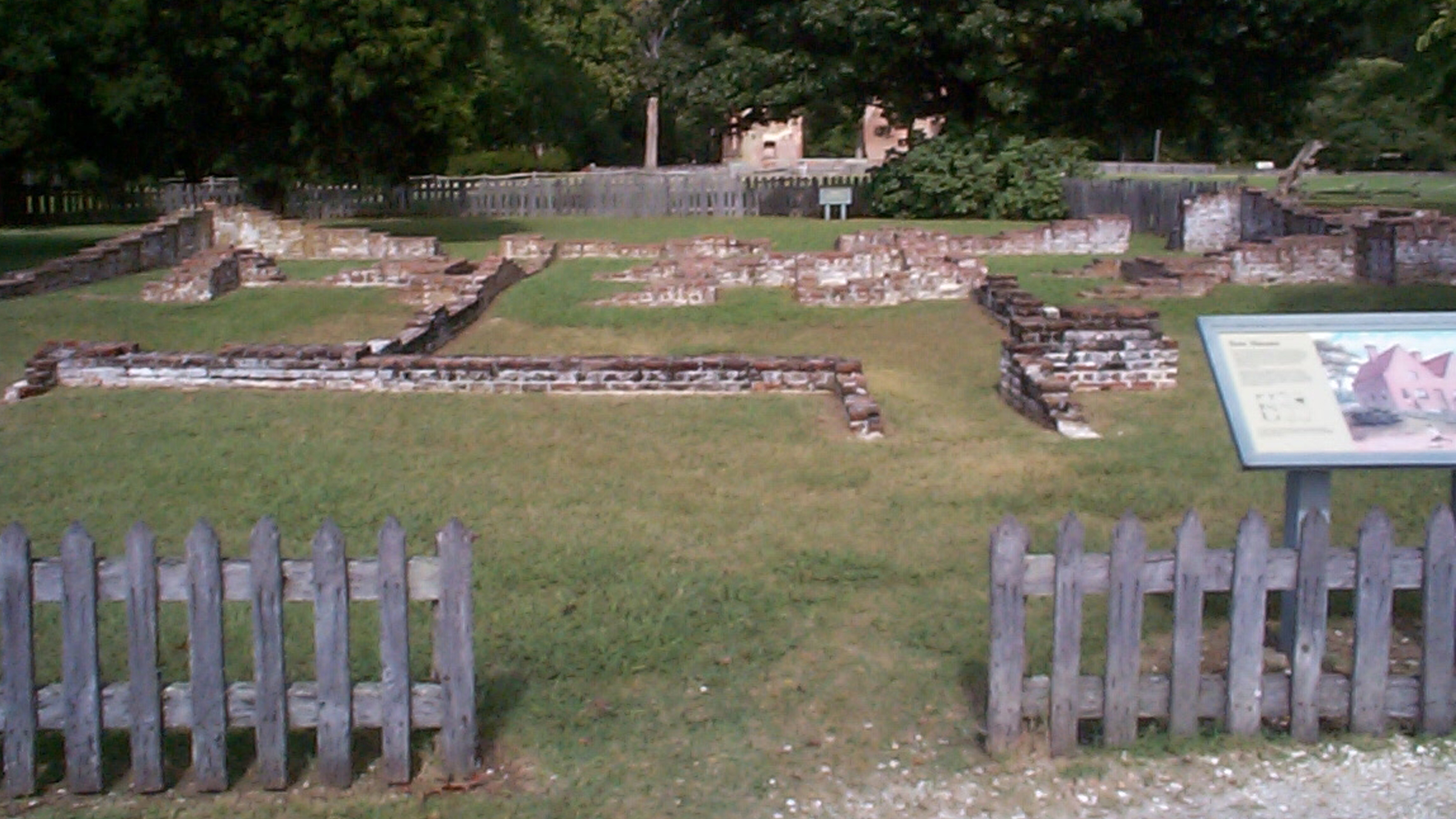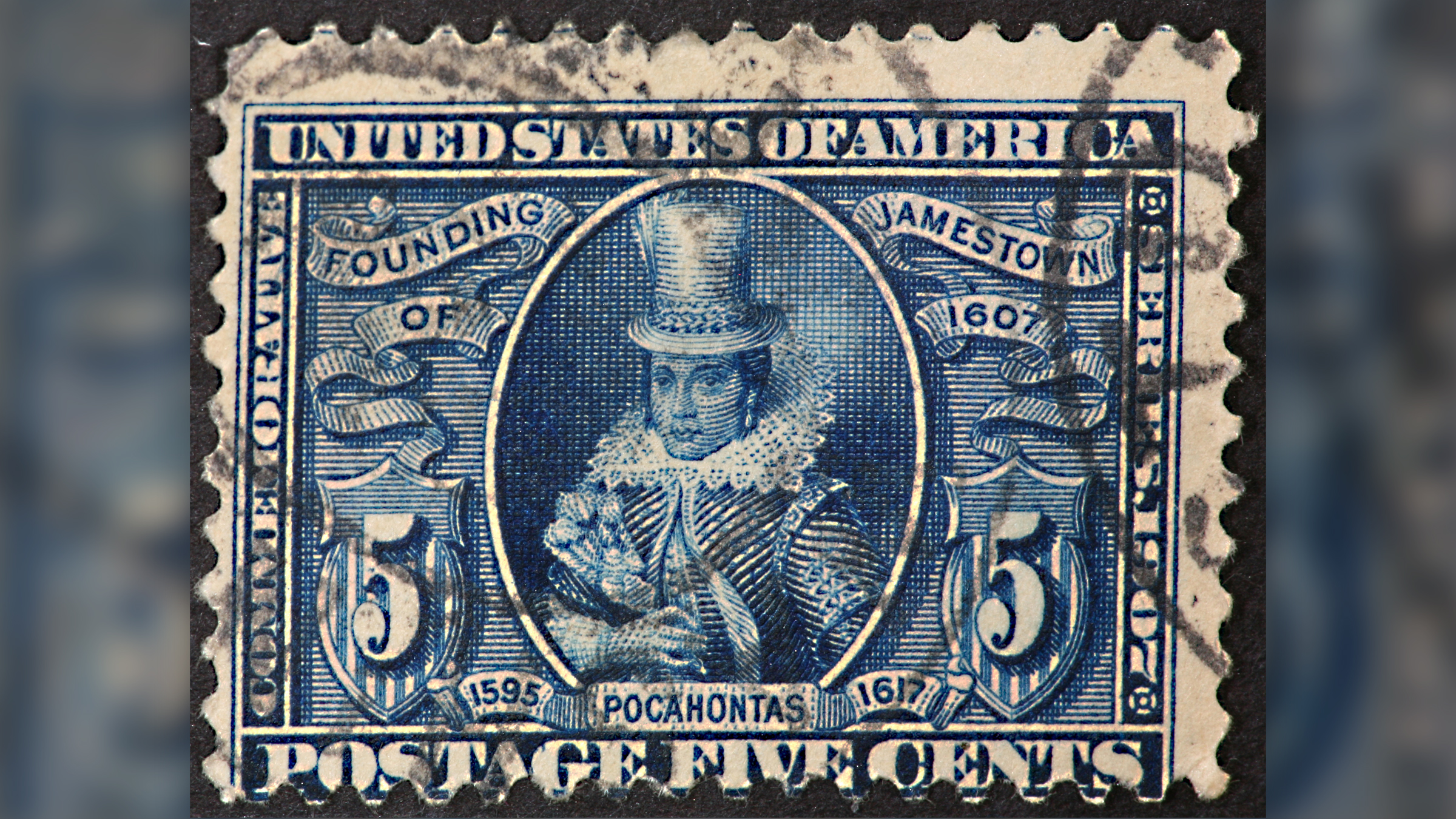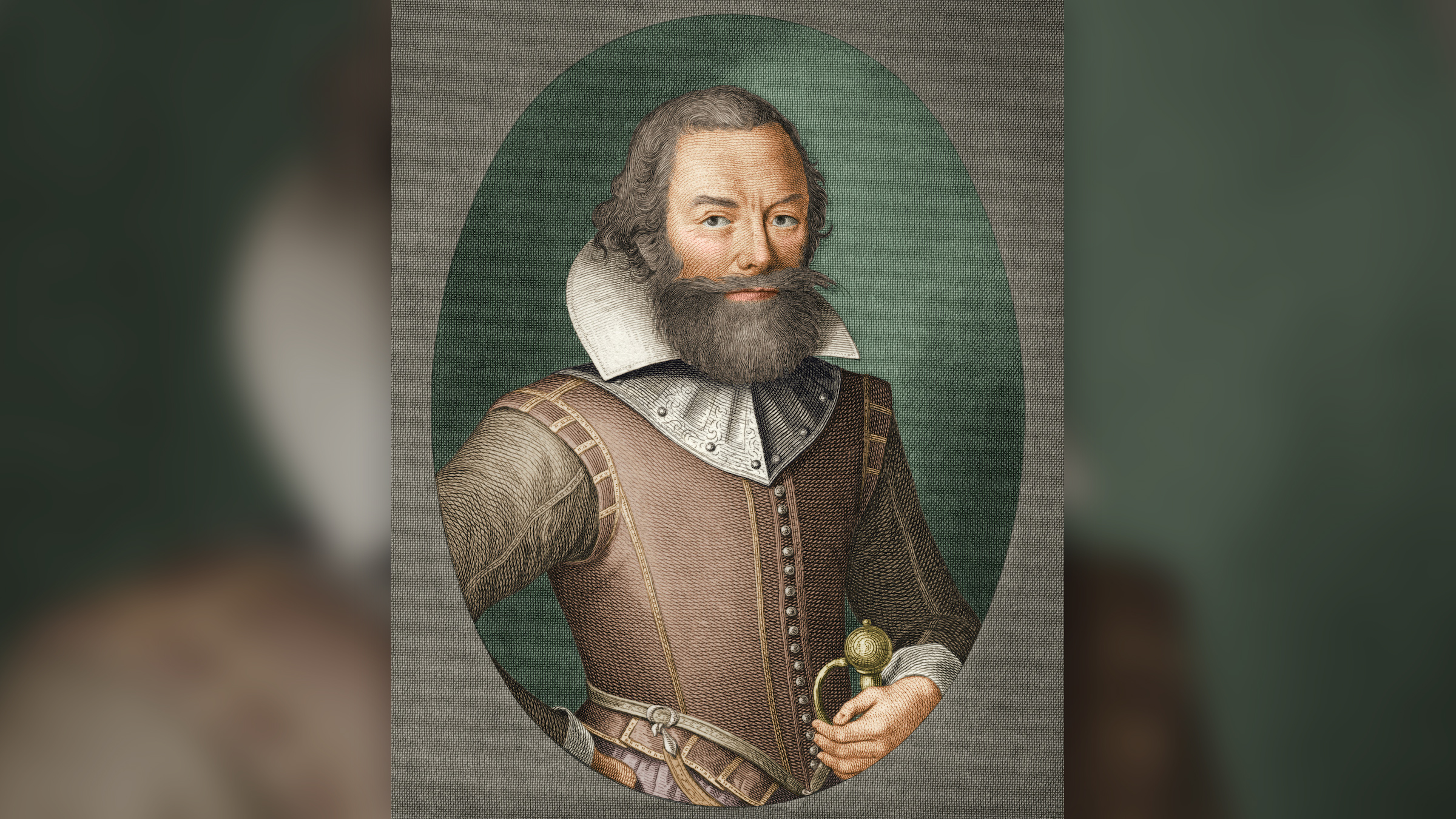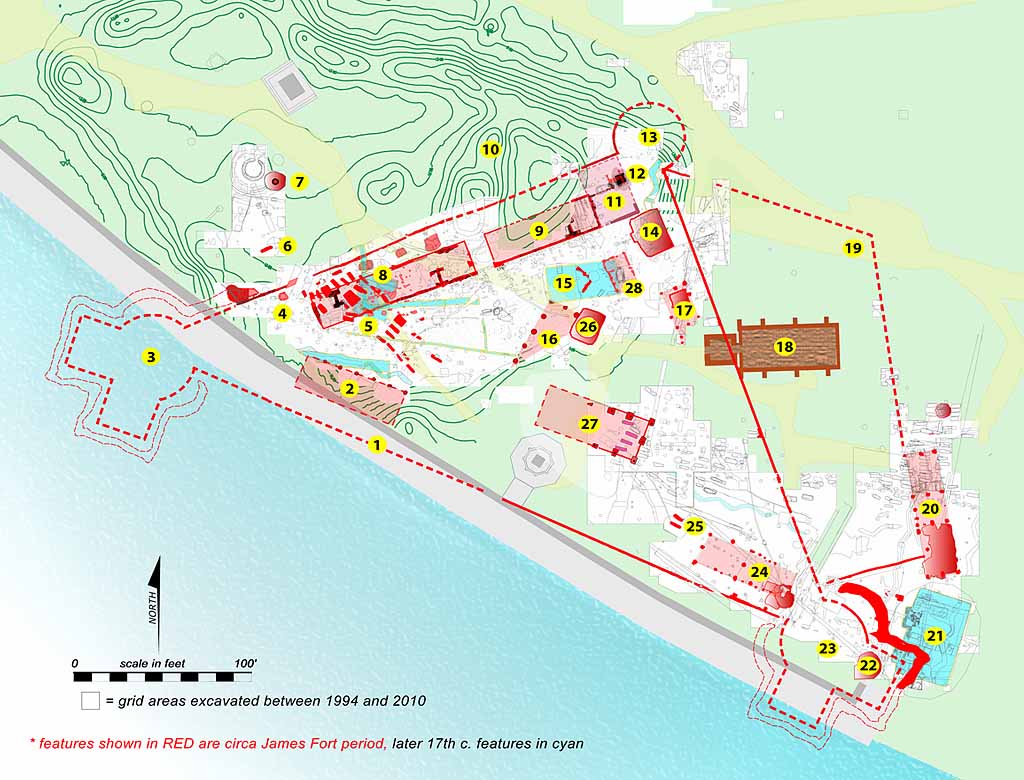Jamestown Colony: Facts & history
The 17th-century colony where Pocahontas met John Smith.

- Colonization of the Americas
- Disastrous early years
- Pocahontas & John Smith
- "Starving time"
- Forcing 'colonists' to Jamestown
- Improving fortunes
- Slavery in Jamestown
- First representative assembly
- All the single women
- An attack too late
- New Towne
- Rediscovery of the original fort
- Additional resources
- Timeline
- Bibliography
Jamestown, founded in 1607, was the first successful permanent English settlement in what would become the United States. The settlement existed for nearly 100 years as the capital of the Virginia colony, but it was abandoned after the capital moved to Williamsburg in 1699.
The history of Jamestown (sometimes spelled Jamestowne) includes human cannibalism, enslaved people forcibly brought from Africa and children kidnapped off the streets of London and taken to the colony. Jamestown is the "creation story from hell," wrote Karen Ordahl Kupperman, a professor of history at New York University, in her book "The Jamestown Project" (The Belknap Press of Harvard University Press, 2007).
A preservationist group took over the site in the late 1800s, and today what's left of Jamestown is part of a national historic park with tours, museums and ongoing archaeological digs that continue to reveal new findings. However, rising sea levels caused by climate change may pose a threat to the site, research suggests. There are plans to reinforce a seawall to try to save the site the Washington Post reports.
Colonization of the Americas
Jamestown was not the first successful permanent European settlement in what would become the United States; that distinction belongs to St. Augustine, in Florida, which the Spanish founded in 1565.
At the beginning of the 17th century, England's attempts to colonize the Americas lagged behind other European nations' endeavours. Spain controlled a vast empire in the Western Hemisphere that included much of South and Central America, Mexico, part of the Caribbean and a settlement in Florida. The Spanish were also moving into what is now the American Southwest.
Meanwhile, the French were exploring Canada's northeast and, in time, would establish a highly profitable fur trade in the region.
In the 16th century, the English had attempted to found Roanoke colony, but the venture ended in disaster; the colonists disappeared and were never heard from again, Kupperman wrote. This colony was located in what is now the Outer Banks area of North Carolina, and the colonists may have left to live with local Native American people, a number of scholars have suggested.
Get the world’s most fascinating discoveries delivered straight to your inbox.
In addition to the Roanoke colonists, other European adventurers had sailed along the eastern coast of North America, some of whom ended up living with the Native Americans they encountered, Kupperman wrote. So it's possible that England's Jamestown colonists met the generations of Europeans who came before them.
"It does not seem too fanciful to assume that some colonists in Jamestown, founded twenty years after the last Roanoke colony, might have encountered descendants of earlier transatlantic migrants without knowing it," she wrote.
Jamestown's disastrous early years
The founding of Jamestown had the blessing of England's King James I, and the settlement and nearby James River were named in his honor. However, the settlement was financed and run by the Virginia Company, a joint-stock company that King James I chartered. This company, in turn, was financed by private investors, who expected the colonists to discover a valuable commodity, or a route to East Asia, which would make the enterprise profitable and offer a return on their investment.
The investors in London hoped that some of the "vanished" Roanoke colonists (or their descendants) were still alive and, with knowledge they gained about the area, could guide the Jamestown colonists to minerals and a passage to East Asia, Kupperman noted.
Unfortunately, the company chose to build its settlement on "a disease-ridden, bug-infested swampy island with no source of fresh water," Jerome Bridges, a park ranger and Historic Jamestowne tour guide, told Live Science. Located about 60 miles (94 kilometers) up the James River from the Atlantic Coast, the site was chosen because the settlers had orders from their investors not to take any land that was occupied by the Indigenous people, Bridges said. This policy did not last for long as Jamestown expanded after being established, creating tensions with the Indigenous people living in the area.
Additionally, the colonists' selected spot may have been considered more defensible than other locations that had been scouted, Joseph Kelly, professor and director of Irish and Irish American studies at the College of Charleston in South Carolina, wrote in the book "Marooned: Jamestown, Shipwreck, and a New History of America's Origin" (Bloomsbury, 2018).
The Indigenous people in the area were the Powhatan and were led by Wahunsenacawh, whom Europeans often called "Chief Powhatan: His realm was known as "Tsenacommacah" and it encompassed about 15,000 people who lived in several communities, Historic Jamestowne noted.
When the English landed there in May 1607, they divided themselves into three groups: One group was to build fortifications, a storehouse and some simple houses; the second group was to plant crops; and the third party was to explore the area in search of minerals and a passage to East Asia.
It did not take long for the colonists to run into trouble. Within a few weeks, a force of several hundred Powhatans attacked the settlement. The colonists had not even unpacked their muskets, and so they relied on naval gunfire from the ships that were still off the coast to repel the attackers. "Had the ships not fired their ordnance, the colony would have been overwhelmed," Kupperman wrote.
In the following few weeks, the settlers focused on building a fort, which was a triangular palisade with three bulwarks, or raised platforms, for cannons.
Before long, the colonists started dying. Of the 104 men and boys who landed, only 38 were still alive by January 1608, according to the National Park Service. Research revealed that the colonists' drinking water was salty and contained arsenic. Additionally, food ran out, famine set in, and a particularly harsh winter compounded the misery of the colonists.
"Our men were destroyed with cruel diseases as swellings, fluxes [also called dysentery], burning fevers, and by wars, and some departed suddenly, but for the most part they died of meer famine," wrote George Percy, one of the survivors, in a report on the colony. "There were never Englishmen left in a foreign country in such misery as we were in this new discovered Virginia."
In that first year, the bodies were buried in unmarked graves to prevent the Powhatans from finding out that so many of the settlers had died, according to Bridges. Excavations by William Kelso, director of archaeology for Jamestown Rediscovery at Historic Jamestowne, and his team revealed 29 burial shafts close to the west palisade wall inside the fort. The team thinks these graves likely hold many of the colonists who died in 1607.
Two of the excavated grave shafts contain two bodies each. According to the Historic Jamestowne website, the colonists likely resorted to double burials because so many men were dying in a short timespan. Twenty individuals died in August 1607 alone, and multiple burials saved energy and time.
The body of a boy, who was around 14 years old, was found with a small arrowhead next to his right leg, which suggests he had been shot shortly before he was buried. Percy recorded that a boy was slain during combat with Powhatans in the first month of the settlement, and it's possible that these remains belong to that boy.
Pocahontas & John Smith
The well-known story of how Pocahontas, daughter of Chief Powhatan, saved Captain John Smith's life very likely did not happen, at least not the way most people have heard it (and most certainly not the way the 1995 Disney animated movie told it), Bridges said.
Smith, who was elected president of the colony's council in 1608 after most of the councillors died or became incapacitated, wrote that the colony depended on trade with friendly Powhatan tribes to survive. Powhatan's people often visited the settlers when they weren't fighting the colonists, according to Bridges. The chief's daughter, about 10 years old at the time, was a frequent visitor to Jamestown, delivering messages from her father and bringing food and furs to trade for hatchets and trinkets, Bridges said.
She also liked to play, and would spend time turning cartwheels with the boys of the colony. Her name was actually Matoaka, and Pocahontas was a nickname meaning "Little Wanton" in Algonquin, according to Historic Jamestowne's website.
Smith later wrote in his book "The Generall Historie of Virginia, New-England, and the Summer Isles," published in 1624, that at one point during an expedition in December 1607, he was captured and brought to Powhatan. He was first welcomed and offered a feast. Then he was grabbed and forced to stretch out on two large, flat stones. People stood over him with clubs as though ready to beat him to death if ordered. Suddenly, Pocahontas rushed in and took Smith's "head in her arms and laid her owne upon his to save him from death," Smith wrote. The girl then pulled him to his feet. Powhatan said that they were now friends, and he adopted Smith as his son, or a subordinate chief.
Smith's tale has become legend, and he romanticized it in later writings, Historic Jamestowne noted. Smith told the story only after Pocahontas converted to Christianity in 1614. And if Smith's story is true, this mock "execution and salvation" ceremony was traditional with Powhatan tribes, and Pocahontas' actions were probably one part of a ritual, according to Historic Jamestowne.
Jamestown's "starving time"
Although the colony had been resupplied, along with 100 new settlers, in January 1608, the settlers hit another low during the winter of 1609 to 1610 — a period that became known as the "starving time," according to Historic Jamestowne. By this time, Smith had been forced to return to England due to gunpowder injuries, and the colony's new governor, Thomas Gates, had been shipwrecked on the island of Bermuda along with essential supplies.
By this point, relations with the Powhatans had deteriorated to the point where trade was impossible and the Jamestown fort was under siege. When the colonists ran out of food, they "fed upon horses and other beasts as long as they lasted, we were glad to make shift with vermin, as dogs, cats, rats and mice," Percy wrote. Recent research has confirmed that dogs were eaten at Jamestown and that these dogs were at least partly native to North America. Historical records indicate that boots, shoes and leather were also consumed, and archaeological evidence confirms that some colonists resorted to human cannibalism to survive.
In May 1610, Gates made his way from Bermuda to the colony on makeshift ships made partly from wood found on Bermuda. Finding only 60 survivors at Jamestown, he gave the order to abandon the settlement but not to burn it. As the group set out to sea, however, they encountered a fleet led by English merchant and politician Lord De La Warr, with fresh supplies and new colonists, so they returned to Jamestown and repaired the fort. (The state of Delaware was later named after De La Warr.)
Forcing 'colonists' to Jamestown
During the colony's early years, it was difficult to convince new settlers to go to Jamestown; as a result, some people, including prisoners and those living on the streets, were sent against their will, British writer Jennifer Potter wrote in her book "The Jamestown Brides: The Story of England's 'Maids for Virginia'" (Oxford University Press, 2019). The city of London even raised money to send London's homeless to Virginia, wrote Potter, noting that King James I was in favor of it. Many of the homeless sent were males.
In 1618, the Virginia Company became particularly interested in getting homeless children to the colony as children were believed to be "more pliable than adults," Potter wrote. Instructions were issued to London's constables to apprehend street children and take them to a place where they would wait to be taken overseas. Poor families were also coerced to send children they couldn't support to Jamestown, Potter noted.
Jamestown's improving fortunes
In the following decade Jamestown's situation improved. Martial law was imposed, solving, however harshly, some of the discipline problems — such as people ignoring orders — experienced during the first three years of the colony, according to Historic Jamestowne.
Until this point, the colonists had failed to find a marketable commodity that would help fund the settlement and develop its economy, but this problem was solved in 1612, when a settler named John Rolfe experimented with tobacco seeds ― possibly from Trinidad ― and developed a marketable crop that could be exported to England. King James I later gave the Virginia Company a monopoly on tobacco, making the trade even more profitable. He even allowed the company to set up a lottery to provide additional funds for the Jamestown venture, according to Historic Jamestowne.
In April 1613, Pocahontas was captured and brought to Jamestown. Although her captors intended to use her to barter for English prisoners, she turned into a catalyst for peace. She married Rolfe in April 1614 in the Jamestown church, converted to Christianity and took the name Rebecca Rolfe. Her father, Powhatan, reached a peace agreement with the English that allowed the colony to expand its cultivated territory and set up new settlements, including Henrico and Bermuda Hundred.
Now, "after five years' intestine [frequent] war with the revengeful, implacable Indians, a firm peace (not again easily to be broken) hath been lately concluded," Gov. Thomas Dale wrote in 1614.
Pocahontas, Rolfe and their infant son traveled to London in 1616, where she became something of a celebrity. However, she died of an unspecified illness in 1617 while the three of them were preparing to return to Virginia. Rolfe headed to Virginia alone, leaving their son in the care of an English family.
Slavery in Jamestown
In August 1619, a Dutch ship arrived at Jamestown and traded food supplies for the ship's cargo of around 20 enslaved people, who were originally from Angola. "Slavery as it was later defined did not yet exist in the Chesapeake, and some of these Africans lived to achieve their freedom," Kupperman wrote. They worked as indentured servants (as many English newcomers did), but were forced to labor for longer terms. Indentured servants normally had to work for the company for a certain time to pay for their passage and goods given them.
While people from Africa had been brought to the Americas as slaves to work in Central and South America in the 16th century, 1619 marked the first time that Africans were brought to North America to work as slaves at an English colony.
Today, 1619 is regarded as the beginning of a new period in American history. "The unequal social status of African Americans begins with the 246-year period from 1619 to 1865, when slavery was a critically important economic and social institution in American life," a team of researchers wrote in a 2019 paper published in the American Journal of Public Health. As the colony expanded, more slave were brought into Virginia.
First representative assembly
In 1619, Sir George Yeardley, a former colonist who had been appointed governor in 1618, returned to Jamestown from England with instructions from the Virginia Company to create "a laudable form of government" that would create "just laws for the happy guiding and governing of the people there," according to historical documents that can be accessed on Encyclopedia Virginia.
In July of that year, 30 men met for the first time in Jamestown to discuss issues facing the growing colony. "This assembly was the first expression of English representative government in North America," Kelso wrote in his book, "Jamestown: The Buried Truth" (University of Virginia Press, 2006).
All the single women
In 1619, the Virginia Company created a program that encouraged single women to travel to Jamestown, which in its early years had been a predominantly male settlement. The company hoped that more women in the colony would encourage the Jamestown men to settle down, rather than return to England after making some money.
The Virginia Company set a "bride price" of 150 pounds (68 kilograms) of tobacco to be paid by a man to the company who married one of the women, Potter wrote in her book.
Potter tracked down the origins of the women who traveled to Jamestown in 1621 and found that 1 in 6 of the women were daughters of gentry (members of the aristocracy). The rest "represented a microcosm of 'middling' England, with fathers, brothers, uncles, working in respectable trades," Potter wrote, noting that people who knew the women had to attest to their good character, and the women had to go voluntarily, although some may have been coerced by relatives.
An attack too late
After the death of the peacemaker Chief Powhatan in April 1618, war seemed inevitable, Kupperman wrote. With the English colony growing, and the settlers using more land and making more aggressive attempts to convert Powhatan people to Christianity the stage was set for a showdown.
Opechancanough, Chief Powhatan's successor, felt threatened by the growing English presence, which by that time consisted of more than 1,000 people on several plantations. In 1622, he launched a surprise attack in an attempt to wipe out the colony.
The Virginia Company claimed the attack killed 347 people, Kupperman wrote, although the actual death toll was likely higher. The English were forced to abandon some plantations and cluster closer together.
Although the attack succeeded in killing many English, it failed in its aim of pushing them out of the region. More settlers arrived to work on the plantations, and the attack gave the English an excuse to wage war against Opechancanough's people, sparing only the children so that they could be converted to Christianity and forced to work on the English plantations, according to Kupperman.
This war was a take-no-prisoners affair, Kupperman wrote. "In [May] 1623 they [the colonists] invited Indian leaders to a peace parley where they served poisoned wine and then fired on the disabled Indians."
From the start of the Jamestown colony, the settlers held a number of military advantages over the Native American tribes in the region. They had gunpowder weapons, equipment made of steel and iron, as well as armor that could offer some protection from arrow hits, Kelly wrote in his book. The Powhatans, on the other hand, had bows and arrows and melee weapons that may have included clubs, knives and spears.
New Towne
As the Virginia colony grew, Jamestown developed into a thriving port town. Thousands of colonists either passed through to start tobacco plantations farther inland, or settled in Jamestown, which expanded by developing a suburb of sorts called New Towne, situated east of the original fort.
Representative government took hold in the 1620s, and inns and taverns were soon established. The tobacco trade, meanwhile, required warehouses and piers along the shore. Jamestown's well-to-do residents built English-style cottages and houses along New Towne's main road.
With new settlers flowing in, the English gained control of the Chesapeake Bay area and launched new colonies (including Plymouth in 1620) along the Eastern Seaboard of the future United States. In May 1624, the Virginia Company was formally dissolved, and Jamestown became a crown colony with a governor appointed by the king.
With the growth of new settlements in Virginia, and the English colonists' improving military situation in the region, the original Jamestown fort site became redundant. Jamestown remained the capital of Virginia until 1699 — a fire destroyed Jamestown's statehouse in 1698, so the capital moved to Williamsburg, according to Historic Jamestowne.
Rediscovery of the original fort
In 1994, the Association for the Preservation of Virginia Antiquities (APVA) began archaeological work to look for ruins from the original Jamestown fort, Kelso told Live Science. It was widely believed at the time that the fort had been washed away into the James River.
Excavations revealed holes where the triangular palisade had once stood, along with the remains of three bulwarks used to strengthen its defenses. The archaeologists also found the remnants of five churches (one built on top of the remains of the preceding church); row houses, including a structure that appears to be the governor's house; a blacksmith shop; and barracks, among other features.
In 2015 archaeologists uncovered the burial sites of four Jamestown leaders who had been buried in one of the churches. In 2018, archaeologists digging in a church in Jamestown found a headless body that might be that of Yeardley. They are hoping to match DNA from the skeleton and teeth found nearby with DNA from Yeardley's living descendants.
To help visitors learn more about what Jamestown was like, replicas of the triangular fort, a barracks and the original church have been built on their original plots. Some reproductions have been built using similar bricks.
Originally published on July 24, 2018. Additional reporting by Tim Sharp.
Additional resources
Historic Jamestowne's website contains a sizable amount of information about the settlement's artifacts and records. Jamestown is part of a national historical park, and the National Park Service has information on how to visit it. Slavery in the United States has a long history, and recent research has revealed more information about the Underground Railroad that led some people to freedom.
Jamestown timeline
May 1607: Jamestown, named after King James I of England, is founded and consists of 104 men and boys.
August 1607: In this month alone, 20 of the colonists die.
December 1607: John Smith is captured and brought to Chief Powhatan. Smith claims that Pocahontas saves his life, although this is likely not true.
January 1608: Only 38 of the 104 original colonists are still alive; poor water and food shortages contribute to the high mortality rate. 100 new colonists are brought in from England during this month.
Winter 1609-1610: The "starving time" sees some colonists resort to human cannibalism.
May 1610: Governor Gates, who had been shipwrecked on Bermuda, makes his way to Jamestown on makeshift ships. Finding only 60 colonists alive, he gives orders to abandon Jamestown. But while leaving, the settlers encounter a relief fleet led by Lord De La Warr that has fresh supplies and new colonists.
1612: While experimenting with tobacco seeds, John Rolfe finds that tobacco grows well in Virginia, giving the colony a marketable product.
April 1613: Pocahontas is captured and brought to Jamestown.
April 1614: Pocahontas marries John Rolfe, and the two leave for England where Pocahontas becomes something of a celebrity. A peace agreement of sorts is reached between Jamestown and Chief Powhatan.
March 1617: Pocahontas dies in England at around age 21.
April 1618: Chief Powhatan dies; relations between the Powhatans and Jamestown's colonists decline.
1619: A program is launched encouraging women to migrate to Jamestown and marry colonists.
July 1619: First meeting of the colony's assembly
August 1619: A Dutch ship brings more than 20 enslaved people from Africa to Jamestown.
1622: Opechancanough, the successor of Powhatan, launches a surprise attack on Jamestown; more than 300 English people are killed and all-out war breaks out.
May 1623: After agreeing to a peace parley, several Native American leaders in the area are killed after drinking poisoned wine.
May 1624: The Virginia Company is dissolved and Jamestown becomes a crown colony. English settlement in Virginia continues to expand, with Jamestown as the legislative center.
1699: After a fire burns down the legislative building at Jamestown, Virginia's capital moves to Williamsburg. Jamestown itself becomes abandoned.
Bibliography
Kelly, J. (2018) "Marooned: Jamestown, Shipwreck, and a New History of America's Origin" Bloomsbury,
Kelso, W. (2006) "Jamestown: The Buried Truth" University of Virginia Press
Kupperman, K. (2007) "The Jamestown Project" The Belknap Press of Harvard University Press
LaVeist, T. A., Fullilove, M., & Fullilove, R. (2019). 400 Years of Inequality Since Jamestown of 1619. American journal of public health, 109(1), 83–84. https://doi.org/10.2105/AJPH.2018.304824
Potter, J. (2019) "The Jamestown Brides: The Story of England's 'Maids for Virginia'" Oxford University Press

Owen Jarus is a regular contributor to Live Science who writes about archaeology and humans' past. He has also written for The Independent (UK), The Canadian Press (CP) and The Associated Press (AP), among others. Owen has a bachelor of arts degree from the University of Toronto and a journalism degree from Ryerson University.





